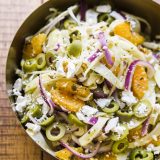The salad in front of me was a delicious cacophony of color, flavor and texture—at once sweet-salty-creamy-crunchy-tender. And it all was born of a lack of sardines.
An unlikely origin story for a dish built around oranges, perhaps. But one Doriana Gesualdi clearly relished telling as I sat in the tiny dining room of Sicilia in Tavola, her trattoria in Siracusa, a 2,700-year-old sun-swept seaport in southeastern Sicily.
Sardines, it seems, were long a marker of wealth on the island, where the culinary influences are as much Greek and North African as Italian. Maybe more so.
But Siracusans weren’t wealthy enough for sardines. So they sufficed with anchovies. And so Sicily’s classic pasta con le sarde became pasta con le acciughe. Ditto for orange and fennel salad with chopped sardines.
“Siracusa is built around cucina povera,” Gesualdi offered as we sipped a dry moscato under the restaurant’s vaulted stone ceilings hung with jellyfish-shaped lights, walls lined with wine bottles.
The salad—insalata di arance, finocchi e olive siciliane—tasted of anything but poverty. A delicate pile of orange segments punctuated by Castelvetrano olives, peppery-anise shavings of fennel, pops of floral salt from plump capers. All tied together by a vinaigrette built on a mash of anchovies and shavings of feta-like ricotta salata. Complex without overwhelming, layered and utterly satisfying.
I couldn’t help but think ... I wouldn’t WANT sardines in this salad. The richness of the anchovies—and their ability to underscore without dominating—made the salad. What Siracusans once considered a mark of making do clearly was a strength.
Back at Milk Street, this salad was easily adapted. Mashed anchovies and olive oil formed the base of our dressing, which we enriched with some of the ricotta salata and capers. As in Siracusa, no additional acid was needed—the orange segments and their juice would provide that. But we did want to bring the orange flavor more to the fore, accomplished by adding some of the zest.
The rest of the salad reflected much of what we had on Gesualdi’s plate: freshly sliced orange segments, lightly crisp shavings of fennel bulb, tender Castelvetrano olives and—for sharpness and crunch—thinly sliced red onion.
The result was a layered and robust salad that nonetheless tasted light and fresh. Cucina povera? Perhaps once. But the richness of this salad tells another tale.




